Explore Alaska’s Inside Passage by Ferry
Southeast Alaska is a magical place. Colorful small towns full of history line the shores. Humpback whales and orcas swim in the waters. Bears and moose wander the wilderness so breathtaking you'll scarcely be able to put your camera down. The southern arm of Alaska that hugs British Columbia is known as the Inside Passage. Roads don't connect this part of Alaska to the rest of the world. Many of the incredible destinations here are only accessible by plane or boat. You don't need to book a massive cruise ship or a private plane to experience Alaska's incredible beauty, however. The Alaska Marine Highway System (www.FerryAlaska.com) is a network of ferries that connect more than 3,500 miles of Alaska's coastline.
Route
Juneau
Gustavus
Glacier Bay National Park
Skagway
Klondike Gold Rush National Historical Site
Add another week
Golden Circle and the Klondike Highway
Haines
Sitka

We've put together an epic itinerary to help you explore two of Alaska's most charming small towns as well as the capital city of Juneau and three national park sites on a thrilling 12-day adventure. You'll see abundant wildlife, catch views of breathtaking glaciers, learn about the area's vibrant history and Native culture, dine on local seafood and find boundless opportunities for outdoor recreation.
Have another week? You can add on an incredible drive through more of Southeast Alaska and Canada's Yukon Territory, checking off a Canadian national park, Kluane National Park and Reserve, as well as another ferry to a can't-miss coastal town.
Here's everything you need to know about taking the Alaska Marine Highway System to enjoy Juneau and Admiralty Island National Monument, Gustavus and Glacier Bay National Park, Skagway and Klondike Gold Rush National Historical Park, as well as the Golden Circle and Sitka along Alaska’s Inside Passage.
Tip: If you're short on time, Juneau and Sitka both have an airport serviced by Alaska Airlines and Delta with direct flights to Seattle.
Everything You Need to Know About the Ferries
Whether you choose to book part or all of the transportation for your Alaska vacation on the Alaska Marine Highway System, the journey itself is part of the adventure.
From the deck of your vessel, you'll see stunning views and incredible wildlife. Don't forget to pack your camera. Your captain will be sure to alert you of nearby wildlife and interesting sights along the way.
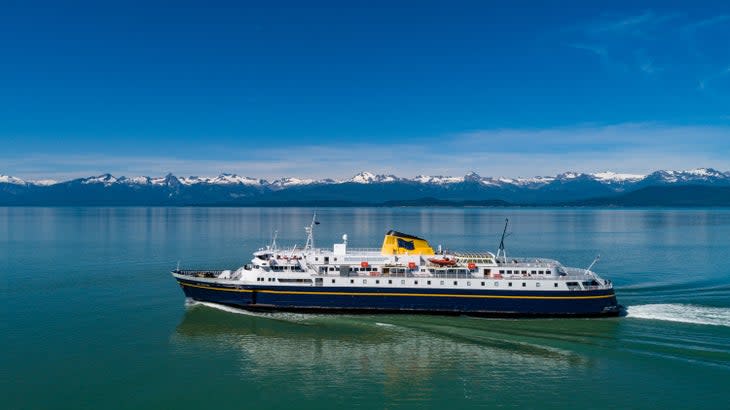
The Alaska Marine Highway System has fares for any sort of traveler. Whether you're heading to Alaska with your RV in tow or you're walking on with your bike or kayak, you'll find the type of ticket you need.
The first thing you'll need to consider is whether to bring a vehicle. This whole itinerary is very doable without a car, but if you plan to drive the Golden Circle Loop into Canada, or would like more freedom to explore, you'll want to reserve your tickets as far in advance as possible since vehicle space, and especially RV space, is more limited than walk-on space.
Ferry service from Bellingham, Wash., to Juneau, Alaska takes two and a half days, so after you decide if you'll be bringing your car, you'll need to decide where you want to sleep. For travelers that prefer a more secluded trip and a bed, reserve a cabin with full facilities including a private bathroom with a shower. There are two, three and four berth cabins to choose from, which makes it an ideal way for families to travel. Cabins are booked by trip, not by person or night and they are reserved quickly, so book as far in advance as possible.
If you're looking for a more adventurous and affordable option, bring your sleeping bag, or even your tent, and camp out in one of two public spaces on board. The heated solarium has lounge chairs to curl up in and tents can be pitched on deck, just make sure to bring duct tape to secure your tent. These wide open spaces are great ways to meet your fellow adventurers.
On board the larger vessels that travel between Bellingham and Juneau, you'll find full-service dining with hot and cold meal options, a movie theater and indoor and outdoor public spaces to relax in as you travel to Alaska. Public restroom and shower facilities are available for those who don't book private cabins. Amenities vary on the smaller ships that make shorter trips, but all vessels have food available for purchase and restrooms.
Pets are welcome as you travel on the ferry as well. They remain on the vehicle deck where they stay in your vehicle, or in an approved carrier. The captain will call for relief breaks for your pet on multi-day journeys.
Tip: The ferries don't stop in every destination on this itinerary every day. This itinerary is built from the 2022 summer schedule; be sure to check the ferry schedules at www.FerryAlaska.com before booking lodging, tours and rental cars.
Alaska Inside Passage 12-Day Itinerary
Day 1-3: Bellingham, Wash., to Juneau, Alaska
Journey to Alaska’s Inside Passage from Bellingham, Wash., an hour and 30 minutes north of Seattle. Ferries depart for Juneau on most Wednesdays and select Saturdays. On Wednesdays, you'll depart on the ferry Matanuska in the evening and arrive in Juneau on Saturday morning. The ferry makes stops along the way in Ketchikan, Wrangell and Petersburg, Alaska. The several-hour stop in Ketchikan is long enough that if you so wish, you could get off and explore locally on foot. Just make sure to check with the purser on duty ahead of the stop on what you'll need to re-board the boat. The stops in Wrangell and Petersburg are approximately an hour-and-a-half, so it's probably best to relax on board.
Day 3-4: Juneau
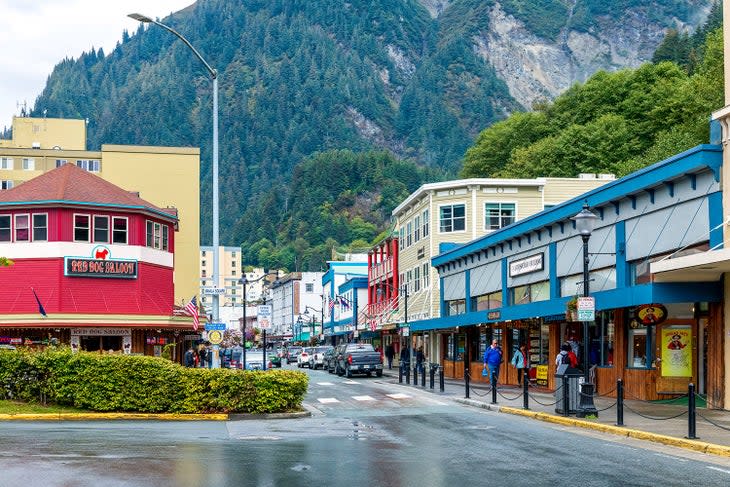
After disembarking, spend two days exploring Alaska's incredible capital city of Juneau (www.traveljuneau.com). Like many cities and towns in Alaska, Juneau quickly grew when gold was discovered in the area. What was once Native fishing grounds quickly became a booming mining town, producing what would be equivalent to $7 billion worth of gold today. Now, it's a city that combines fascinating history with its natural surroundings, making it a great place to spend the weekend.
No trip to Juneau is complete without a visit to Mendenhall Glacier. One of the most accessible glaciers in North America, it's part of the expansive Juneau Icefield and only 13 miles from downtown. Stop by the Mendenhall Glacier Visitor Center to learn about the glacier through exhibits and a short film and to take a short walk to a viewing platform. If you have more time, hike the 2-mile Nugget Falls Trail, which follows Mendenhall Lake and ends in a 377-foot waterfall pouring into a lake filled with icebergs, the glacier in the background. It's a stunning, family friendly hike.
The 4-mile West Glacier Trail also follows the lake but brings you to the edge of the glacier itself. If you're looking for even more adventure at the glacier, there are plenty of tour opportunities with local outfitters from kayaking in Mendenhall Lake to hiking across the glacier to ice caves. Glacier travel can be extremely dangerous and is not recommended without a guide.
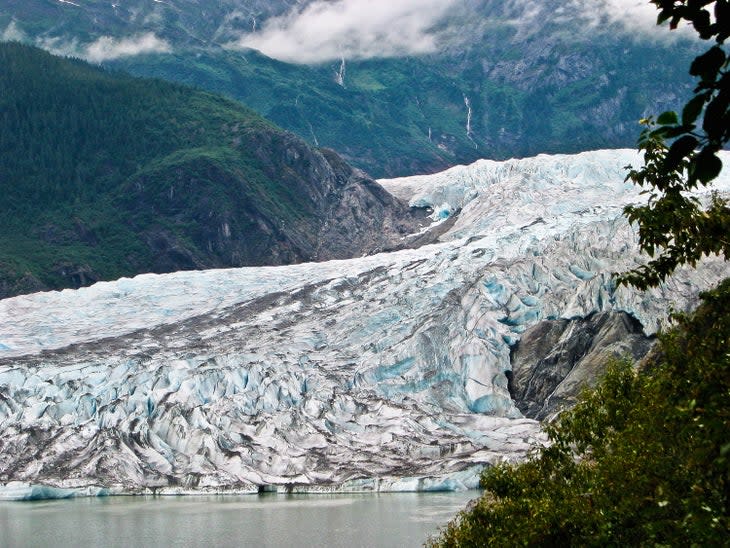
Juneau is an excellent place to spot wildlife. The waters near Juneau are home to 600 humpback whales in the summer, as well as orcas. April through November are the best months to see these incredible mammals. Book a whale watching tour to get out on the water and see them up close.

If you want to see bears, you're in luck. Black bears are often spotted near the city. If you want to see grizzly bears, called brown bears in this part of the country, Admiralty Island National Monument has the highest density in North America. Access the Pack Creek Bear Viewing Area via a chartered float plane. The journey is an adventure itself as you'll take off and land on the water and enjoy breathtaking aerial views along the way. Once you land, you'll be met by a ranger and hike a mile to an observation tower to watch the bears feed on salmon. Between June 1 and Sept. 10, permits are required for Pack Creek. During peak season, July 5 - Aug. 25, only 24 permits are issued each day giving you an experience of solitude. Permits open Feb. 1 on recreation.gov, or you can book your trip with a guide company who takes care of permits for you.
Don't miss Juneau's vibrant downtown. Head to Heritage Square to see the Sealaska Heritage Institute, a non-profit helping preserve Tlingit, Haida and Tsimshian cultures. Also located in the square is the Walter Soboleff Building, which houses the largest installation of art from these tribes in Alaska, including a cedar clan house you can walk through. Stroll the waterfront and learn about Juneau from the perspective of its residents as installations share audio histories with you. Check out Heritage Coffee Roasting for a cup of locally roasted coffee, or on the other end of the day, Alaska Brewing Company for a local beer.
Day 5-8: Juneau to Gustavus and Glacier Bay National Park
From Juneau, take the ferry LeConte on a half-day trip to the town of Gustavus, gateway to Glacier Bay National Park. Here you can spend three days exploring the park and the town before heading back to Juneau.
Gustavus

The small community of Gustavus (pronounced guh-stave-es) (www.gustavusak.com) is home to only 650 year-round residents but is one of the friendliest towns you'll ever find. You might be surprised as folks wave to you whenever they pass, but that's just how people are around here. Don't forget to wave back. Start at the Gustavus Beach Park, which is a beautiful spot for a stroll with views of the Fairweather Mountains. Thanks to its formation by glaciers, the town is extremely flat.
Originally called "Strawberry Point," one of the main attractions you'll find while hiking near Gustavus is wild berries. The 2.2-mile Nagoonberry Loop Trail is a great place to start. This beautiful trail winds through forests and meadows and has plenty of its namesake berry, which is similar to a raspberry. You'll also find strawberries early in the summer and blueberries come July. No need to pack snacks. The best way to avoid negative bear encounters is to ensure that you don't surprise these incredible creatures. Make noise or sing as you hike and be aware of your surroundings. Carrying bear spray is always suggested when hiking in Alaska. Stop by Icy Strait Wholesale, also known as Toshco, for bear spray before your hike, as bears also love summer berries.
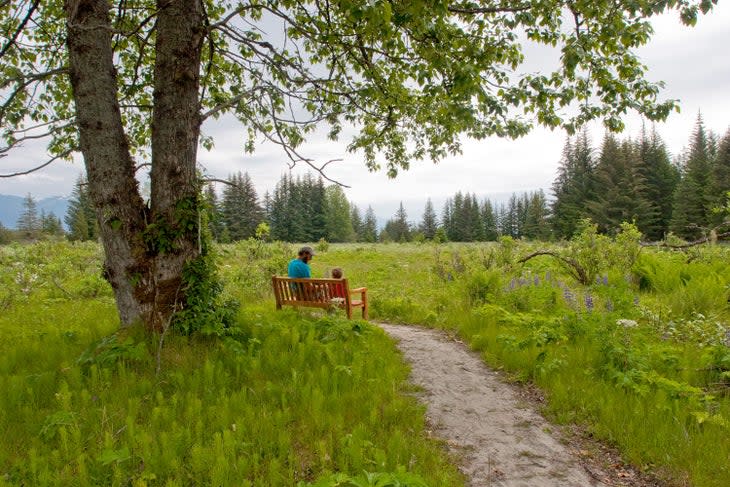
Check with your bed and breakfast, cabin or lodge to see if they have bikes for your use while in town as most do. You can ride to the heart of the tiny downtown, known as Four Corners. Stop by Fireweed Gallery, Coffee and Tea House where you'll find local art, coffee and tea and morning fuel including crepes and biscuit sandwiches.
Glacier Bay National Park

This stunning park encompasses 3.3-million acres. Hike through temperate rainforests, kayak through glacier-fed waters, see those same glaciers calving and spot whales on a boat tour to the fjords of Glacier Bay. Read our guide to Glacier Bay National Park.
Take the ferry back to Juneau on Thursday and spend the night before heading to your next destination.
Day 9: Juneau to Skagway
The next day, book passage again on the ferry LeConte for a half-day ride to the historic town of Skagway. The moment you step off the ferry, you'll feel as if you've been transported back in time. Colorful buildings line the streets housing shops and restaurants. Many of the buildings you'll stroll past are from the Klondike Gold Rush, built between 1897 and 1910. A town ordinance requires any new buildings in the historic district to match the historic aesthetic, so the entire street looks like it was plucked from more than a century ago.
Day 9 - 12: Skagway and the Klondike Gold Rush National Historical Site

Skagway (www.skagway.com) is home to an incredibly unique national park site. The Klondike Gold Rush National Historic Site is made up of several different units, which tell the story of the turn of the century's mad rush to find gold in the Yukon. Read our guide to the Klondike Gold Rush National Historical Site.
Another excellent way to get a taste of Gold Rush history is by riding the White Pass and Yukon Route Railroad. An engineering marvel in its day built to carry ore to awaiting ships, today the railroad helps tourists get a glimpse at Alaska's beauty. Take a two-hour scenic ride to the summit of White Pass, or bring your passport and ride all the way to Fraser, British Columbia, where you can rent kayaks or Carcross, British Columbia, where residents can trace their ancestry back to the Ice Age. Either way the views will be incredible. Book a package with Packer Expeditions to ride the train to the Laughton Glacier stop where you'll go on a guided hike to see the glacier up-close. In Fraser, outfitters offer guided kayaking tours of glacial lakes. Return via the train or book a bus tour to see the views from the Klondike Highway on the trip back.
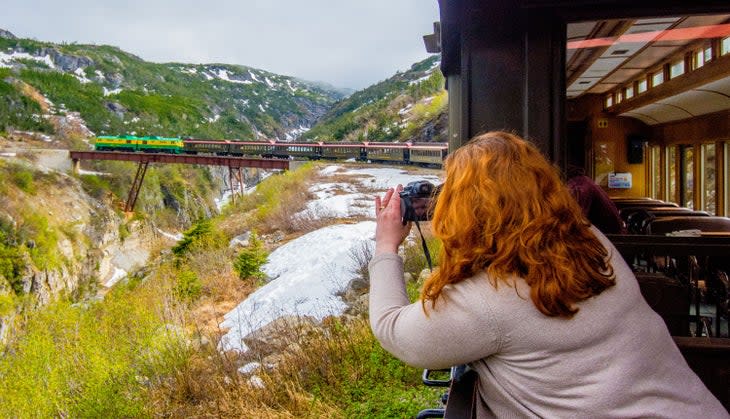
Hiking is incredibly accessible from Skagway. Families will enjoy the Yakutania Point Trail, which crosses a footbridge with views of the mountains and a distant glacier. Hikers looking for a workout should check out the Dewey Lakes Trail. It's only a 3.45-mile, one-way hike to the upper lake, but the trail gains 3,000 feet, making it feel like climbing stairs the entire way. The gorgeous alpine lake ringed with impressive peaks is a well worthy reward, however. While the trails near town don't see as much bear activity as the ones near Dyea, make sure to always be bear aware.
When it's time to grab a bite to eat, Skagway is full of great restaurants, many that specialize in seafood with views of the waterfront. While you'll have tons of possibilities for dining during your stay, don't miss Skagway Brewing Co. Its newly built brewing facility, restaurant and taproom building is extremely sustainable. Cooking oil is turned into biodiesel, which heats the building. The CO2 that's created as a by-product of brewing beers is pumped to the top floor to grow greens in an aeroponic garden. The garden was spurred on by kitchen staff who were disappointed in the quality of greens that they could source. Most of the food in Skagway has to be brought by barge from Seattle, which sparked this sustainable way to make sure the greens on your plate are as fresh as possible. You'll find gourmet pub fare on the menu with seafood dishes, salads and burgers, many of which feature the brewery's beers in the recipes.
You'll find plenty of places to rest after a day of adventuring from chain hotels to private cabin rentals to historic B&Bs. A favorite? The Skagway Inn, which used to be a brothel and is now a great bed and breakfast with a restaurant featuring some of the best food in town, including vegetarian and vegan dishes.
Head back to Juneau on the LeConte again and from there, fly back to Seattle.
Add Another Week
Want to explore more of Southeast Alaska and Canada's Yukon Territory? Add another week to drive the Golden Circle into Canada and visit the charming town of Sitka. Don't forget your passport.
Day 13 - 16: Drive the Golden Circle
You'll need to bring your car for this one, or rent one in Skagway. You'll be driving the Golden Circle north over the Canadian border, through two Canadian provinces and back south to Alaska where you'll end up in Haines, Alaska. Haines is less than 20 miles as the crow flies from Skagway, but the Golden Circle is the only overland route to get there. It's just over a 350-mile drive and can be done in a day, but we suggest allotting yourself several days to explore the towns along the way.
Head north from Skagway on the Klondike Highway, where you'll quickly cross over the Canadian border. Canadian customs is eight miles north of the border at Fraser, British Columbia. If you took the White Pass and Yukon Route Railroad here earlier in your trip, you can decide if you want to stop and explore stunning glacial lakes or continue on.
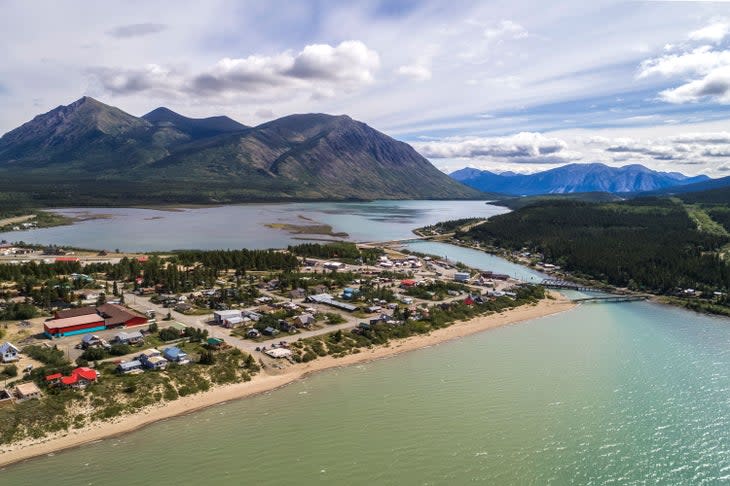
Cross over into Yukon Territory and stop in the town of Carcross at the north end of Bennett Lake. Originally called "Caribou Crossing" and shortened to its current name, you'll find more kayaking here, along with world-renown mountain biking trails. The area is a tiny desert filled with sand dunes that used to be at the bottom of a glacial lake.
Continue north to Whitehorse, which is the territorial capital. Whitehorse is one of the larger cities in this part of Canada, so in addition to its incredible outdoor recreation, it offers tons of cultural opportunities. Stroll local shops, explore the waterfront and learn about the history of the region in museums from the Yukon Beringia Centre for Ice Age exhibits to the Kwanlin Dun Cultural Centre showcasing this First Nation's art and culture.
From Whitehorse, head north and then west to the town of Haines Junction. This town is a gateway to Kluane National Park and Reserve, Canada's national park home to the country's tallest mountain. The 19,551-foot Mt. Logan, along with the other stunning peaks of the Saint Elias Mountains, tower over town. This is a great place to spend a few days hiking and camping.
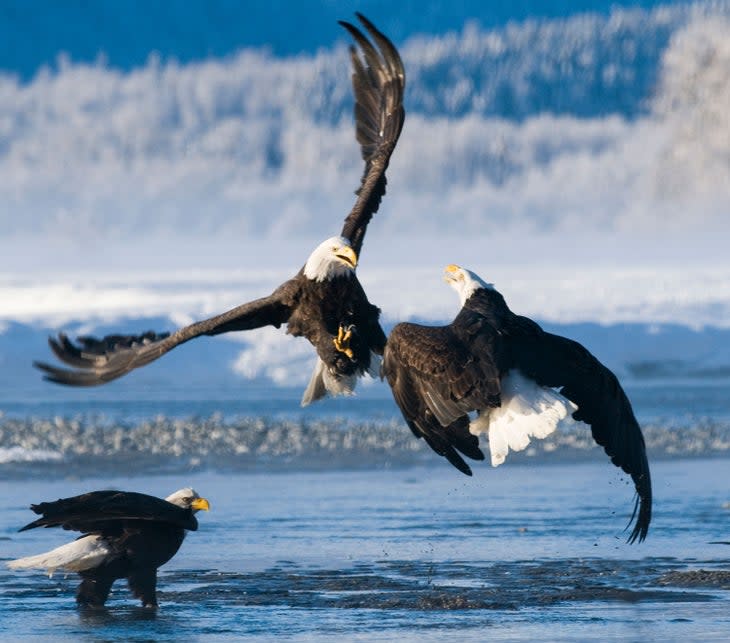
Continue south, back over the border, and end your drive in Haines, Alaska. Check out the Chilkat Bald Eagle Preserve, an Alaska state park, to see one of the world's largest concentrations of our country's national bird. A 2-mile trail will allow you to view these majestic creatures. Don't miss one of the most interesting museums you might ever encounter. The Hammer Museum was started by an independent collector whose wife insisted he do something with his multitudes of hammers. She expected he'd get rid of them, not open a museum, but now visitors can see the breadth of his collection.
Day 17: Haines to Sitka
From Haines, board the Matanuska again, this time heading for Sitka. This seaside town is worth a stop, but note that ferry stops are limited in Sitka, so you'll be spending a week or two here if you get off and want to complete your itinerary by ferry. You could skip stopping in Sitka and head back to Bellingham, Wash., now if you have your car in tow. Or, if you're traveling without your car, spend a few days exploring Sitka before catching a direct flight back to Seattle.
Day 17-19: Sitka

While the small towns you've visited so far in Alaska’s Inside Passage all share some of the same features, Sitka (visitsitka.org) will feel a little bit different. It's the only town on this itinerary situated on the open ocean. This means marine wildlife is abundant from whales and sea lions to otters living in the kelp beds. Commercial fishing boats line the harbor. The weather in Sitka is a bit different, too. You'll find that it's mild and temperate, even in the winters with weather more like Seattle than what you might imagine of Alaska. Sitka has been home to the Tlingit people for more than 10,000 years. Today, a third of the population is Tlingit, creating a vibrant community that connects both past and present.
Pick up a sandwich from Tlingit-owned Our Town Catering and hit the trails or the water. Head to the trails at the Sitka National Historical Park, which tells the story of the 1804 battle between invading Russian traders and the Tlingit people. You can tour the historic Russian Bishop's House and walk the beautiful coastal trails lined with totem poles. Be sure to check trail conditions in advance as trails are occasionally closed for bear activity.

Hundreds of small islands dot the protected Sitka Sound, making it a great place to kayak. Rent a kayak or book a guided tour from Alaska Travel Adventures or Sitka Sound Ocean Adventures to explore the islands and hopefully spot some of the sound's bountiful wildlife.
If you missed spotting bald eagles or bears on your hike or kayak, stop into two unique wildlife rehabilitation centers in town. The Alaska Raptor Center rehabilitates injured and sick eagles and other birds. Their indoor/outdoor facility is also home to resident birds who can't return to the wild and help educate visitors on raptors in Alaska.
The other rehabilitation center is Fortress of the Bear which helps orphaned cubs find new homes. Alaska law doesn't allow bears to be released back into the wild, so the non-profit helps place cubs with organizations like zoos and sanctuaries to keep them from being destroyed. The organization's staffers are pushing for legislation to allow rehabilitated bears to return to Alaska's wilderness since similar programs in Canada have succeeded. In months where the bears aren't hibernating, usually April through October, you can visit and see eight resident bears.
Explore the very walkable downtown Sitka, full of locally-owned businesses. This town is full of creatives. You'll find handmade chocolates and soaps, the Alaska Pure Sea Salt Company and local delicacies like spruce-tip jelly, made from the new growth of the beautiful Sitka Spruce and even kelp pickles. Visit St. Michael's Cathedral, a stunning example of the architectural influence Russian traders had on the town. It was destroyed by a fire in 1966, but many artifacts were saved, thanks to a bucket brigade, and a replica of the church was built.
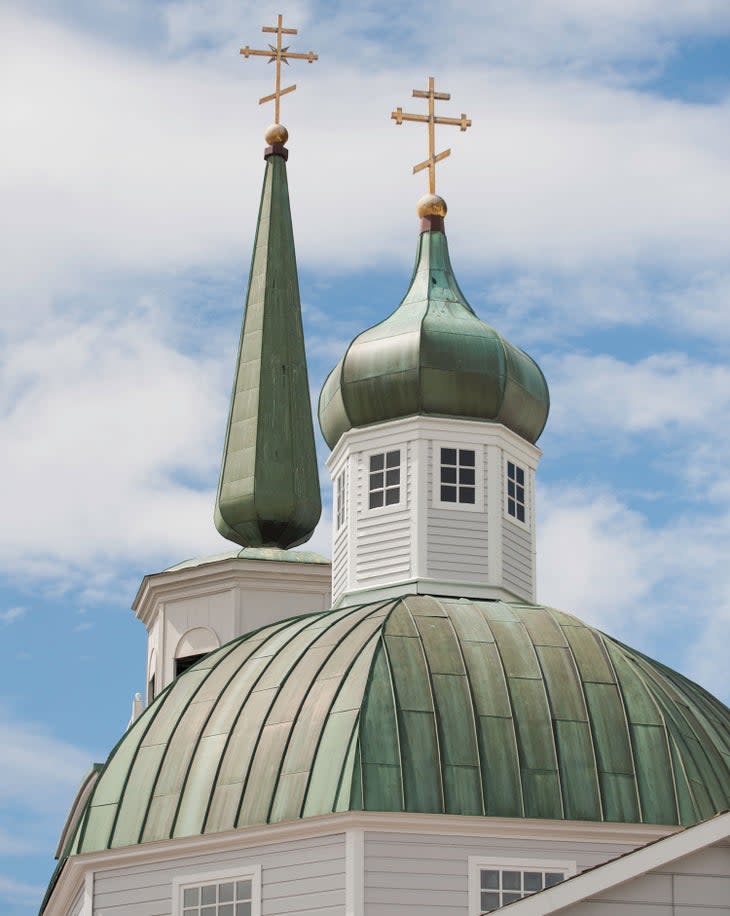
When it's time for dinner, you'd be remiss not to try the local seafood, fresh from the largest marina system in southeast Alaska. You'll find salmon, halibut, cod and Dungeness and king crab, depending on the season. Several of Sitka's restaurants, including Beak Restaurant and Halibut Point Crab & Chowder, serve local seafood dishes. Or, if you're staying somewhere with a kitchen head for the marina. Keep an eye out for handmade signs and buy local catch straight from the fishermen to prepare at your accommodations.
From Sitka, fly back to Seattle to round out your adventure on Alaska’s Inside Passage.
Book your ferry passage at www.FerryAlaska.com or call one of their reservations specialists at 1-800-642-0066.
For exclusive access to all of our fitness, gear, adventure, and travel stories, plus discounts on trips, events, and gear, sign up for Outside+ today.

